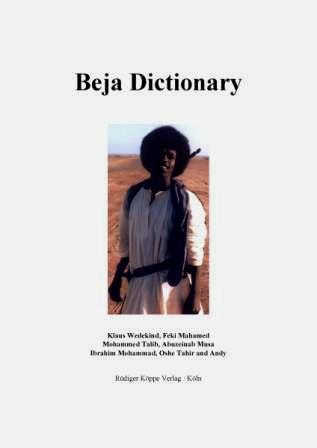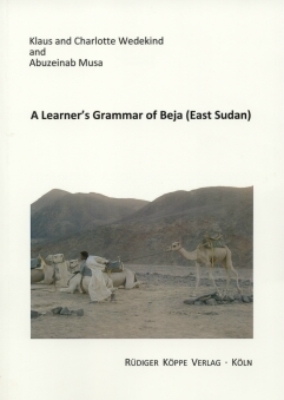



Beja holds a special position within the Afro-Asiatic languages, since it is the only Cushitic language classified as North Cushitic. Beja speakers number about 1 million – but ethnic Beja people may be as many as 2 or 3 million. They live in Southern Egypt, Eastern Sudan and Northern Eritrea. The Atmaan dialect – one of the Beja varieties which is mainly spoken in the Sudan.
The Beja-English-Arabic part and the English-Beja-Arabic part each contain more than 6,000 entries.
Under PDF documents you will find the full text of the review by Martine Vanhove.
Under these links you will find a Learner’s Grammar of Beja, containing grammatical explanations and more than 300 language examples, and further descriptions of Beja in paper collections:
The Beja Dictionary (Beja-English-Arabic/English-Beja-Arabic), which is more precisely a lexicon than a dictionary, is the result of the joint efforts of seven contributors from Germany, Eritrea, where the late German SIL linguist Klaus Wedekind was based in 1996‑2003, and Sudan. It includes some 6,000 entries from Beja varieties spoken in Eritrea, Sudan and Egypt. The more precise dialectal distribution, in particular between the three main dialects (Northern, Central and Southern, all represented in Sudan, but not in the other two countries) is not mentioned. However, what is duly mentioned in the foreword is that the entries were checked with Bishaari speakers, that is, speakers of a Northern variety. So, one may assume that this dialect is at the core of the lexicon, as most entries indeed suggest, in particular the presence of a short vowel u, typical of this variety. This dictionary is meant, primarily, for Beja speakers in Eritrea.
The short foreword by Klaus Wedekind, and the postscript by Charlotte Wedekind and Jonah Wedekind, briefly explain the circumstances under which the dictionary was compiled. The trilingual introduction by Mohammed Talib and Feki Mahamed provides succinct information about the Beja people, their language and its dialects, and the Latin‑based alphabet used in the lexicon, which is the official orthography in Eritrea (the sole country where Beja has official status and is taught in schools) and which was adopted by the Beja Cultural Studies Center of the Red Sea University in Sudan for its publications. [...]
Compiling lists of vocabulary is a long and painstaking enterprise, for which the authors are to be thanked, but no bilingual or multilingual dictionary is perfect, and this one is no exception. Nevertheless, used with caution, it is a very welcome addition to our knowledge of the Beja lexicon, and to the already existing wordlists, lexicons and dictionaries (Almkvist 1881‑1885; Reinisch 1895; Roper1928; Hudson 2012; Wedekind et al. 2007), and the forthcoming dictionary by Vanhove and Hamid Ahmed (in preparation). It also must be acknowledged that it is the first lexicon of Beja that provides systematic translations into (classical) Arabic, a most welcome novelty.
Martine Vanhove in LLA Linguistique & Langues Africaines, 9(1)/2023, 1-6
© 2026 by Rüdiger Köppe Verlag – www.koeppe.de